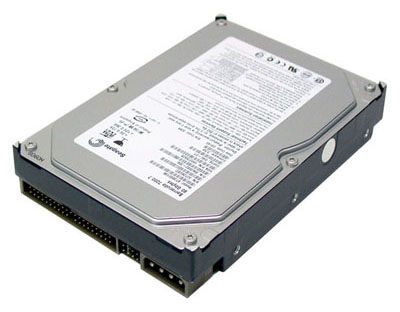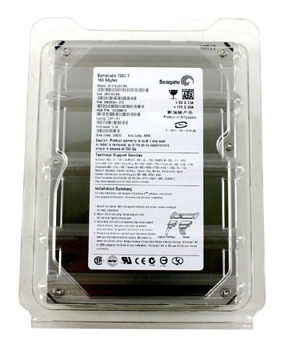Buyer's Guide - Entry Level, October 2004
by Jarred Walton on October 6, 2004 12:05 AM EST- Posted in
- Guides
Hard Drives
As with most of the other options, there are tons of potentially good hard drive choices. The three main factors that influence hard drive performance are the RPM, the amount of cache, and the capacity. While many might insist on a drive with 8 MB of cache, it is not strictly required for the budget segment, and getting a 2 MB cache drive can save you about $10. Getting a 5400 RPM drive instead of a 7200 RPM drive, on the other hand, is not recommended.The question of how much capacity you need is really up to the individual. Some people would never even manage to fill a 20 or 30 GB drive, while for others, even 200 GB may not be enough. These days, the cheapest hard drives still tend to cost about $50, and anything smaller than 40 GB will not be any cheaper. In fact, 80 GB drives are only slightly more expensive than 40 GB drives, and we feel that the extra $10 is worth it to double your capacity.
With most hard drives now spinning at 7200 RPM or faster, noise has become more of a concern. Particularly with an office computer, many people will find high noise levels to be distracting. Earlier 7200 RPM drives have been known to have a high pitch whine. Most companies have now upgraded to the latest spindle technology known as fluid dynamic ball bearings, which help to all but eliminate the noise of the hard drive. Many Western Digital Caviar and Maxtor drives use the older bearings and so, unless noise does not bother you, we recommend that you search out a drive that uses the fluid dynamic bearings. This is available on Hitachi, Maxtor, Samsung, Seagate, and Western Digital drives now, but take some time to make certain that it is on the model that you are purchasing.
One trend that we are happy to see is the return of longer warranties. For a while, many companies were shifting to 1-year warranties. Now, most of them have returned to 3- or even 5-year warranties on their drives. Seagate has led the way with a standard 5-year warranty on all of their models, including previously purchased drives! Others have only increased their warranty on current models. Just remember that the warranty only covers the physical hard drive, so you still need to make backups of your important files.
The final topic relating to hard drive choice is the interface. Parallel ATA - also called IDE or EIDE - has been around for a long time, so it tends to be slightly cheaper. The budget office motherboard that we recommended does not support anything else, but the gaming motherboard offers support for up to two Serial ATA connections. There is little to no difference in real world performance between the interfaces, at least in the budget segment, but SATA does use a thinner cable that is easier to work with. All things being equal, we would prefer a SATA drive over a PATA drive, and we would even be willing to pay a little more for it if necessary.

Office Hard Drive Recommendation: Seagate 80 GB 7200 RPM 8MB PATA
Price: $67 shipped
With all the considerations listed above, it is difficult to argue with the choice of a Seagate hard drive. You get the full five-year warranty (two years more than most of the competition), quiet operation, good performance, and plenty of storage. You could save a few dollars by choosing some alternative, but it just does not make a lot of sense. Should you need more storage space, models with 120 GB and 160 GB are available and have a lower cost per GB, but 80 GB should be plenty for even the most demanding office work.

Gaming Hard Drive Recommendation: Seagate 160 GB 7200 RPM 8MB SATA
Price: $107 shipped
Our recommendation for budget gamers remains with Seagate, due to their impressive set of features and reliability. The difference is that we have chosen to go with a SATA drive instead of PATA, and we have increased the recommended capacity to 160 GB. That may seem like overkill, but when you consider that Far Cry, Unreal Tournament 2004, and Doom 3 all require about 4 GB of hard drive space - and that's without any of the extra content that you can find online - it is very easy to run out of storage for your games. If you uninstall games that you are not currently playing, you can get around this potential difficulty, but that is not the most convenient of solutions. You can always downgrade to a 120 GB or 80 GB drive if you disagree. The cost per GB of an 80 GB SATA drive is 89 cents, while the cost per GB of the 160 GB drive is 71 cents. If you can afford it, you get double your storage space for about a 50% price increase.










53 Comments
View All Comments
JarredWalton - Monday, October 11, 2004 - link
52 - ??? If you have such a high-end graphics card, are you actually thinking about pairing it with a budget systesm? Anyway, yes, it should work, unless it's an AGP Pro graphics card and your motherboard doesn't have a Pro slot. A 550W PSU should be sufficient, regardless. Anyway, you ought to look into getting an Opteron, Athlon 64, or Pentium 4 to go with that card. :pnurazlanshah - Sunday, October 10, 2004 - link
can i use 3DLabs Wildcat Realizm 200 8x AGP 512MB G-DDR3 ($1500) with my NF2 8xagp motherboard even if i have 550w power supply?MasterFlash - Friday, October 8, 2004 - link
Nice article. I like your choice of components. My comp is similar to your recommendations: Antec SLQ-3700, Biostar MN7CD Pro mobo, Athlon XP 2500+, 2x512Mb DDR400 Crucial RAM, ATI Radeon 9800 Pro, 160Gb Seagate HDD, Toshiba DVD drive, generic 19" CRT.JarredWalton - Friday, October 8, 2004 - link
#49 - Foxconn and CasEdge have been suggested in our past budget guides, so I wanted to branch out a bit. :) I'm not too keen on their look, either, but that's just me.Bulldog66209 - Friday, October 8, 2004 - link
I've found that Foxconn/Supercase/CasEdge toolless cases offer good value, are easy to work with, and many are available with truly usable 400 watt power supplies. The local Micro-Center recently had a CasEdge TU-155 on sale for $31. The included power supply rated as capable of supplying 28 amps of 3.3V, 40 amps of 5V, and 17 amps at 12V at a nominal 400 watts. This compares favorably to the Antec which, although only rated at 350 watts, provides 28 , 35, and 16 amps.spartacvs - Friday, October 8, 2004 - link
To #41What the hell do you put on those HD? I have a 40Gb: few games, few applications, few videos, few mp3 and some small softwares (k9, avant browser, etc). It's only 2/3 full. And when it's 3/4 full, it just mean it's time for a little cleanup. Sure you can easily overload 2 x 120 Gb but your need are certainly not what most of the peoples needs.
mino - Friday, October 8, 2004 - link
#45 Nicely said.I completely agree,
It just seems to me it's very important to explicitly say what you mentioned here in your post.
It's beacause there is a HUGE amount of people who save those $20 or so, just because they have no idea what the result may be. The worst(not rare) case is, when such a person is a white-box builder...
Other than that I forgot to mention in my previous post that this guide is MUCH better then last one(not saying that was bad).
Keep good work Jarred.
And one suggestion for case to consider - since I think for value machine reliability is FAR more important than look - I recommend this YeongYang Cetus YY-5601 as an alternative with PSU I mentioned before.
We have been buying only these cases for a year now on and they ones of the best in $50-60 range.
they're available for inastance here http://store.yahoo.com/directron/yy5601.html
Ivo - Friday, October 8, 2004 - link
The review is very nice and useful but several additional aspects could be addressed too:1. The Video/Audio performance for 'Home entertainment' (without gaming - for older buyers :-).
2. The Cool & Quite (Eco) features of the components and systems.
3. The micro-ATX SFF systems (not barebones) for LAN-parties, Home-PCs etc.
4. The LCD-displays.
5. The long-term price (future software compatibility) of the systems.
In that sense, possibly, only systems with Athlon64 CPUs (with good cooler) are really interesting.
JarredWalton - Thursday, October 7, 2004 - link
Regarding several of the case comments, that's pretty much what I had in mind. I've built quite a few PCs for friends, family, and even myself. The downsides to the cheaper cases often more than outweigh the $20 or so you might save. Heck, if it were me, I would even try to get up to the SLK-3700 or Sonata cases by Antec (although oddly enough I prefer the 3700 over the Sonata - other than the PSU, of course). They're *so* much nicer to work with than a lot of the other sub-$100 cases.Really, cases are a personal choice. What I often consider gawdy or ugly, some people think is "l33t". Conversely, what I think is simple and elegant others will say is boring and dull. Buy what makes you happy, but if you get a cheap, generic PSU and it fails after a few months, don't say we didn't warn you!
Anyway, thanks to all for the kind comments. I'll look at including some other miscellaneous recommendations in the future. I do have to say that after reading Kris' MythTV articles, I've been itching to build a TiVo-esque PC. I just keep repeating to myselft, "You do NOT need another PC... you do NOT need another PC..." Heheh.
Neurorelay - Thursday, October 7, 2004 - link
Whoops, I see the 6600...okay, mistook the number. :)